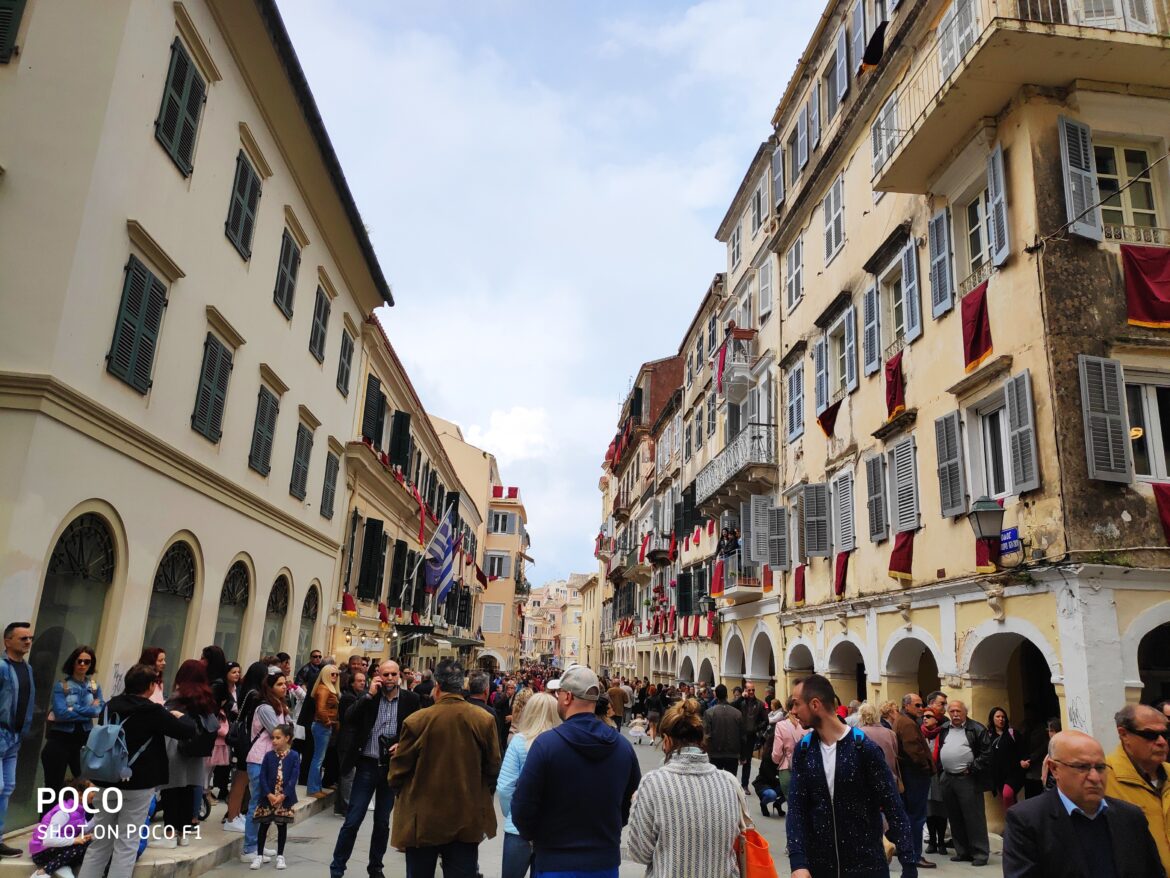Corfu Easter, also known as “Pascha” in Greek, or Holy Week or “Semana Santa,” is a significant event in the Orthodox Christian calendar. The week-long celebration is rich in religious and cultural traditions, and Corfu Island is one of the best places to experience the festivities. The festivities leading up to Easter Sunday are filled with religious processions, customs, traditions, feasting, and vibrant celebrations. It is a time when Christians commemorate the crucifixion and resurrection of Jesus Christ. Corfu Easter Week is a particularly unique and vibrant celebration that is characterised by its colourful and theatrical traditions. The Easter Celebrations last 8 Days but gain a steady motion beginning Saturday itself. Below is the breakup day by day and then later event by event.
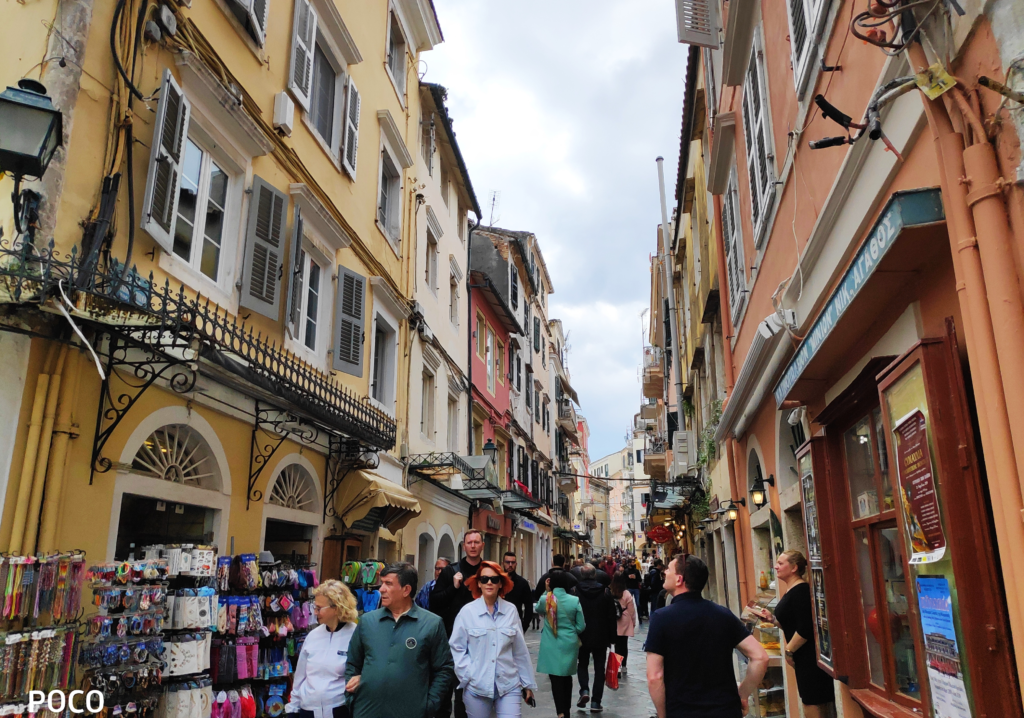
- Lazarus Saturday : Lazarus Saturday is a day of great religious significance as it commemorates the resurrection of Lazarus, a close friend of Jesus who had been dead for four days. It is believed that Lazarus’ resurrection foreshadowed the resurrection of Jesus Christ. In Corfu, the day is marked by various customs and traditions. People attend the church to hear the Gospel of St. John, which recounts the story of Lazarus’ resurrection.
- In the evening, they participate in the custom of the “lampades,” which involves the lighting of small lamps and torches in the streets, symbolizing the light of Christ.
- Food specialties for Lazarus Saturday include “fasolada,” a traditional Greek bean soup, and “koulourakia,” sweet Easter cookies shaped like a braid or a ring.
- The day is also accompanied by traditional Corfiot music, such as the “cantades,” a form of folk song sung in local dialect, and the “kantathes,” a traditional dance performed by men and women in festive costumes.
- Corfu’s streets come alive with the sound of church bells and traditional music. Children and adults gather olive branches and flowers to create Lazarus crosses, which are blessed in church and then used to decorate houses and streets.
- Day 1, Palm Sunday : Corfu Easter celebrations begin on Palm Sunday, which commemorates the triumphal entry of Jesus into Jerusalem.
- On this day, the streets of Corfu are filled with people holding palm fronds and branches, which they wave as a symbol of victory and welcome.
- People gather in the churches to receive palm leaves, which they then take home and hang above their front doors or windows to ward off evil spirits.
- Traditional Corfiot music is played in the streets
- The traditional food for Palm Sunday in Corfu is “bakaliaros skordalia,” a dish made with fried salt codfish served with a garlic and potato dip called “skordalia.” “Avgolemono,” a traditional Greek egg and lemon soup, is also commonly served.
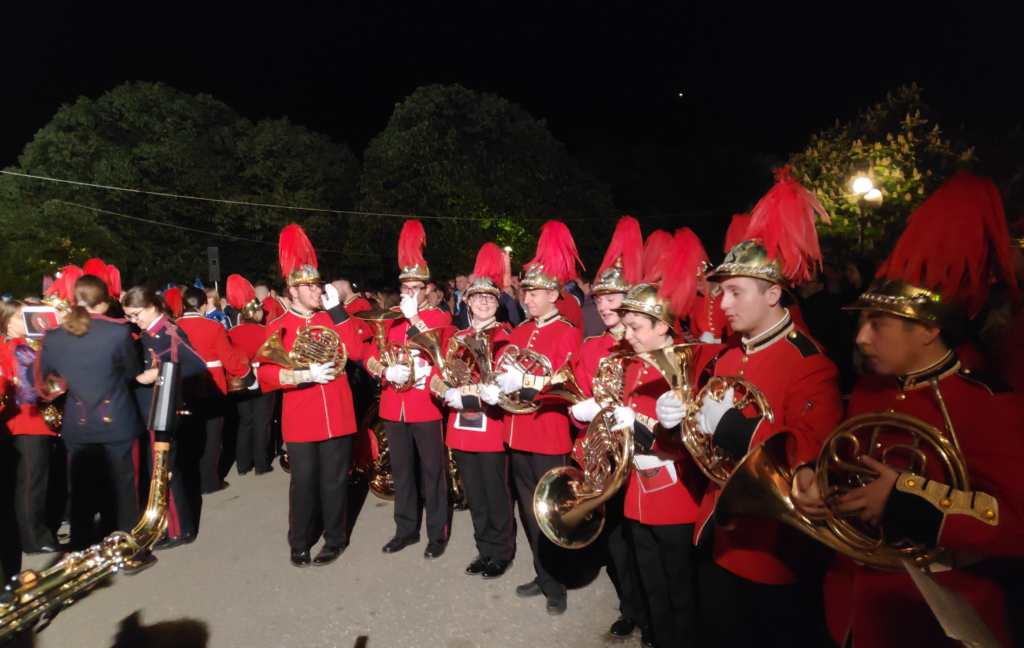
- Day 2: Holy Monday: On Holy Monday, the people of Corfu start preparing for the upcoming events of the week. Celebrations start with different musical and poetry events in the evening
- Holy Monday is Considered Easter Shopping Day. Its a day when Corfu’s beautiful winding lanes and charming narrow alleys called as Kantounia, fill up with locals making a bee line to browse the stores. Traditional Easter delicacies such as Fogatsa, Kolompina, Paschalina Koulourakia, and Mantolato are freshly prepared and sold, and chocolate Easter eggs are also available.
- On the enchanting evening of Holy Monday, the captivating chimes of church bells echo throughout the island, beckoning one and all to come and partake in the evening service.
- In addition to the religious observances, people in Corfu also traditionally eat vegetarian and seafood dishes on Holy Monday, as it is a day of fasting and abstinence. One of the traditional dishes served in Corfu is “bourdeto,” which is a spicy fish stew made with scorpionfish, eel, and sometimes octopus. The stew is seasoned with onion, garlic, and red pepper flakes and is typically served with boiled potatoes or crusty bread. And another one is “tsigareli,” a dish made with wild greens. These dishes are typically eaten without meat, as Holy Monday is traditionally a day of abstinence.
- Another popular dish is “bakaliaros tiganitos,” which is fried salt codfish served with lemon wedges. Vegetarian options such as “fava,” a split pea dip, and “ntakos,” a traditional salad made with tomato, feta cheese, and crispy bread, are also commonly served.
- Finally, traditional Easter sweets, such as “tsoureki” (sweet bread with mastic and orange flavor), “koulourakia” (butter cookies), are enjoyed as desserts.
- Day 3, Holy Tuesday : Holy Tuesday is dedicated to the 12 Gospels, which are read in the churches. The locals attend mass and light candles in memory of the 12 apostles.
- The Gospel recounts the story of Jesus predicting his own death and the betrayal of Judas Iscariot. In the evening, they participate in the custom of “mataki,” which involves hanging small decorated boats, called “matakia,” from balconies and windows.
- These boats are often decorated with flowers, ribbons, and other ornaments. This tradition symbolizes the safe return of seafarers and fishermen and is a way of paying tribute to the sea, which has played an important role in the history and culture of Corfu.
- Day 4, Holy Wednesday : Holy Wednesday is a day in Christianity that commemorates the betrayal of Jesus by Judas Iscariot, who acted as a covert spy among the disciples and had agreed to identify Jesus to the authorities in exchange for 30 pieces of silver.
- Many people in Corfu attend church services, which are typically held in the evening. During the service, the Gospel account of Judas’ betrayal is read, and the priest may also perform the sacrament of Holy Unction, which involves anointing the faithful with holy oil and offering prayers for healing and spiritual strength. Unctions are chanted in all churches and the Municipal Choir adds its unique style and sound by performing a concert of religious music at the Municipal Theatre.
- In terms of food, the traditional dish for Holy Wednesday in Corfu is “fakes me rizi,” a hearty soup made with lentils and rice. This dish is said to symbolize the simplicity and frugality of the Lenten fast, and it is typically eaten after the church service.
- Overall, Holy Wednesday is a day of reflection and mourning for Christians, as they remember the betrayal of Jesus and the role of Judas in his arrest and crucifixion.
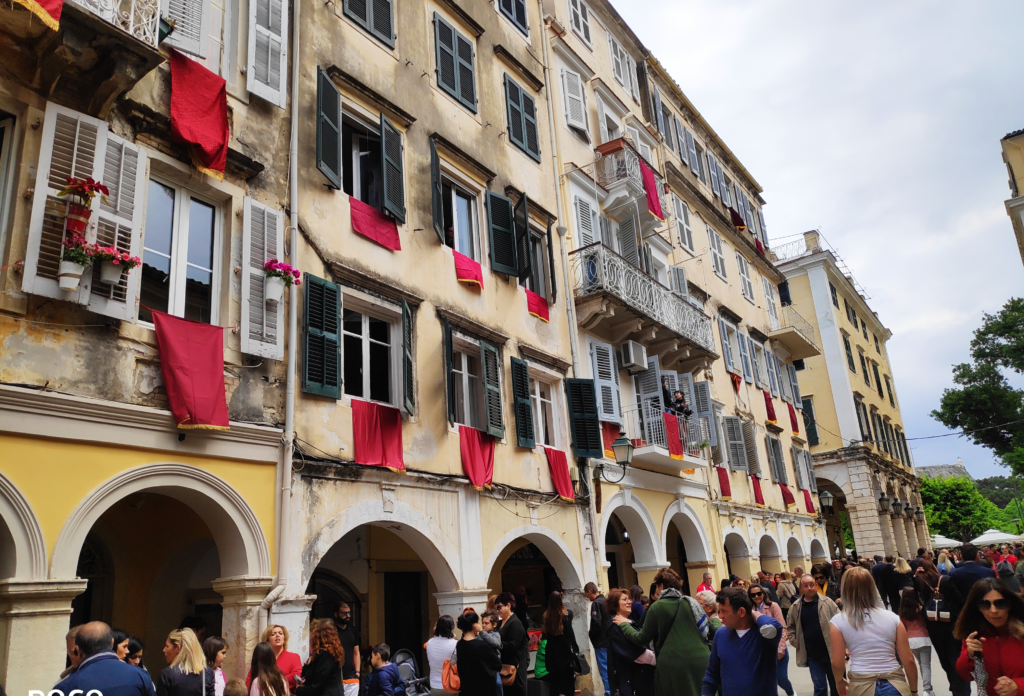
- Day 5, Maundy Thursday : Maundy Thursday commemorates the Last Supper of Jesus Christ with his disciples before his arrest and crucifixion.
- In Corfu, Holy Thursday is marked by several church services, including the “Service of the Holy Passion” and the “Service of the Twelve Gospels.” During these services, passages from the Gospels recounting the events of the Last Supper, the betrayal of Jesus by Judas Iscariot, and his trial before Pontius Pilate are read aloud. It is also the day when Greeks traditionally dye eggs red, with the red color symbolizing the blood of Christ, while the egg represents the empty tomb of Jesus after His Resurrection.
- In the evening, a special ceremony takes place in the church, known as the “Washing of the Feet.” This ceremony reenacts Jesus washing the feet of his disciples as a symbol of humility and service. The priest washes the feet of twelve members of the congregation, representing the twelve apostles, and the ceremony is accompanied by hymns and prayers.
- During the day, many people prepare traditional foods for the upcoming Easter celebrations, such as “mageiritsa” soup, which is made with lamb offal and herbs. Some families also dye eggs red, which is a symbol of the blood of Christ.
- During Holy Thursday in Corfu, the preparation of the “artoklasia,” a special bread, is an important tradition. This bread is blessed during the “Service of the Holy Passion,” and then cut into small pieces and distributed to the congregation as a symbol of communion and sharing. The artoklasia is a significant aspect of the Holy Thursday rituals, as it represents the unity and community of the faithful.
- Day 6, Good Friday : Day 6 of the Corfu Easter Week is Good Friday, which is a day of mourning and solemn remembrance for Christians. On this day, Corfu town is draped in black, and many businesses remain closed as a sign of respect.
- In the morning, a special church service is held to commemorate the crucifixion of Jesus. During this service, the Gospel account of the crucifixion is read, and the faithful are invited to venerate a wooden cross, which is adorned with flowers and candles.
- In the evening, a solemn procession called the “Epitaphios” takes place, in which a symbolic tomb of Christ is carried through the streets of Corfu town. The procession is accompanied by mournful music and chanting, and the faithful carry candles as a sign of their devotion. The charming streets and squares of Corfu are filled with numerous Epitaphs, each originating from different churches and winding through the town.
- The highlight of the Good Friday celebrations in Corfu is the “Mantata,” a custom that involves groups or slow-moving crowds of people, dressed in black holding candles and singing hymns, walking through the streets of Corfu town along with philharmonic bands and creating a truly enchanting ambiance. Among them, the epitaph (procession of people) of the Cathedral of Corfu is the most impressive and starts at 10 pm, concluding at midnight. It should not be missed.
- Day 7, Holy Saturday : Day 7 of the Corfu Easter Week is Holy Saturday, a day of anticipation and preparation for the celebration of Christ’s resurrection on Easter Sunday. The day is filled with church services and religious customs.
- In the morning, there is a church service to commemorate the burial of Jesus. This service is called the “First Resurrection,” and it includes the reading of the Gospel accounts of Jesus’ burial and the chanting of hymns and a procession in which the Epitaphios is carried through the streets once again. This time, however, the mood is more joyful, as the procession symbolizes Christ’s victory over death.
- As the day progresses, preparations are made for the midnight Easter Vigil. Homes are cleaned and decorated with flowers and candles, and families gather together to enjoy a festive meal.
- As the sun sets on Holy Saturday, the most dramatic and memorable custom of the Corfu Easter Week takes place – the “botides.” This custom involves the throwing of large clay pots filled with water from the balconies of buildings and houses, creating a loud and spectacular display.
- The “pot throwing event” is undoubtedly one of the most impressive Easter celebrations and a highly anticipated event that draws thousands of both locals and tourists to Corfu Town, all eager to experience the uniqueness of this tradition that is exclusive to Corfu. The event is known for its spectacular display of ceramic pots being thrown out of windows, which symbolizes the discarding of the old and the welcoming of the new. It is a remarkable spectacle that leaves a lasting impression on all those who witness it, making it a must-see event for anyone visiting Corfu during the Easter season.
- The tradition is said to have originated from the Venetian custom of throwing objects from windows to celebrate the end of winter. However, in Corfu, it is associated with the biblical story of the woman at the well who gave Jesus water to drink.
- After the “botides,” the people gather in the church for the “Anastasis,” a service that marks the resurrection of Christ. The priest emerges carrying a candle, symbolizing the light of Christ overcoming the darkness of sin and death.
- At the stroke of midnight on Good Saturday, the official Resurrection ceremony takes place in Spianada Square, and it is a momentous occasion that is celebrated with great fanfare. The event is marked by a stunning display of fireworks that adds to the excitement and joy of the occasion. The church bells also ring out in celebration, and the faithful exchange greetings of “Christos Anesti” (Christ is risen) and “Alithos Anesti” (Truly He is risen).
- This traditional event is highly significant and symbolic, representing the triumph of life over death, and it is celebrated with great reverence and enthusiasm by the people of Corfu. The midnight Resurrection ceremony in Spianada Square followed by Fireworks Display is undoubtedly one of the highlights of the Easter celebrations in Corfu, and it is a truly unforgettable experience for all those who witness it.
- In terms of food, a feast of traditional Easter foods is served. The people of Corfu break their fast with a traditional soup called “magiritsa”, a soup made from lamb offal, rice, and herbs like dill and parsley. The soup is usually thickened with avgolemono sauce, a mixture of egg yolk, lemon juice, and hot broth. Magiritsa is traditionally served after the midnight Resurrection service, as it is the first meal of the Easter feast. It is a symbol of the end of the fasting period and the beginning of the joyous celebration of Easter.In addition to magiritsa, other traditional dishes that may be served during the Easter period in Corfu include:
- Lamb roasted on a spit or in the oven, often flavored with garlic, lemon, and herbs like rosemary and thyme.
- “Pastitsada,” a spicy pasta dish made with rooster or beef cooked in a tomato sauce with cinnamon, cloves, and other spices, served over pasta.
- “Sofrito,” a dish of thinly sliced beef or veal cooked in a garlic and wine sauce.
- “Bourdeto,” a spicy fish stew made with local fish like scorpionfish, cooked in a tomato sauce with hot chili peppers.
- “Kokoretsi,” a dish made from lamb or goat offal (like intestines) wrapped around seasoned meat and roasted on a spit.
- “Tzatziki,” a dip made with yogurt, cucumber, garlic, and dill, often served as an appetizer or side dish.
- These dishes are often accompanied by traditional Easter bread called “tsoureki,” a sweet braided bread flavored with orange zest and mahlab (a spice made from ground cherry pits).
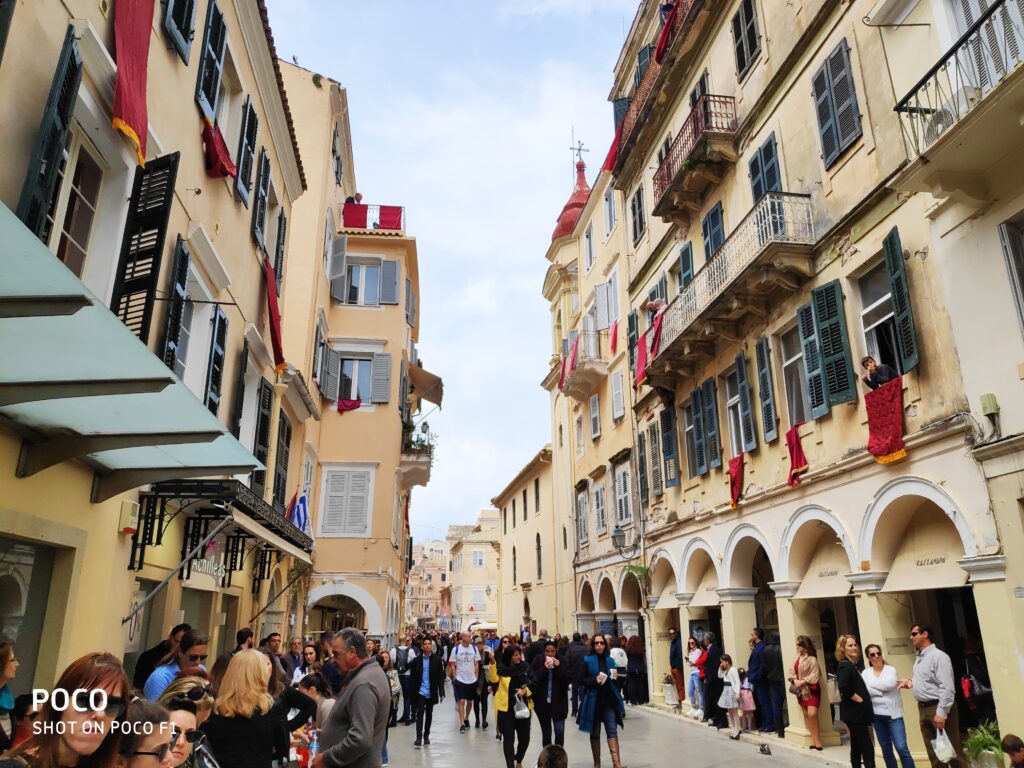
- Day 8, Easter Sunday : Easter Sunday is a day of feasting and celebration and the culmination of the Corfu Easter celebrations and is a joyous day filled with feasting, music, and dancing. After the midnight Resurrection service on Holy Saturday, the people of Corfu break their fast with a traditional soup called “magiritsa” and then enjoy a festive Easter meal with family and friends. The locals attend church in the morning and then enjoy a festive meal with their families.
- The traditional Easter Sunday meal in Corfu often includes roasted lamb or goat, stuffed with garlic and herbs and cooked on a spit or in the oven. Other popular dishes include “kokoretsi,” a dish made from lamb or goat offal (like intestines) wrapped around seasoned meat and roasted on a spit, and “souvlaki,” skewered meat grilled over charcoal and served with pita bread and tzatziki.
- In addition to the meat dishes, there are a variety of vegetarian dishes that may be served on Easter Sunday, such as “gemista,” stuffed vegetables like tomatoes or peppers, and “spanakorizo,” a spinach and rice dish.
- Desserts are also an important part of the Easter feast, and Corfu is known for its delicious sweets. One of the most popular Easter desserts is “tsoureki,” a sweet, braided bread flavored with orange zest and mahlab. Other sweets include “koulourakia,” butter cookies, and “melomakarona,” honey-soaked cookies.
- Throughout the day, there are also parades, music, and dancing in the streets. Traditional Corfiot music, including the island’s unique “kantades” songs, can be heard throughout the town, and people dress in their finest clothes to celebrate the occasion.
Summary of all the Customs and Traditions observed during the Easter Week:
During Corfu Easter, the locals follow many customs and traditions that have been passed down through generations. Here are some of the most significant ones with details on festivities, food, music, fireworks, and celebration:
- Epitaphios: The Epitaphios is a decorated bier with Jesus’ body, which is carried around the streets of Corfu on Good Friday. The procession is accompanied by mournful music and chants.
- Pot Throwing: On Holy Saturday, the locals throw pots and crockery out of their windows to ward off evil spirits and bring good luck.
- Lazarus Crosses: On Lazarus Saturday, the locals create Lazarus crosses using olive branches and flowers. These crosses are blessed in the church and then used to decorate houses and streets.
- Palm Crosses: On Palm Sunday, the locals create palm crosses, which are blessed by the priests and taken home to ward off evil spirits.
- Resurrection Mass: On Holy Saturday, the locals attend the Resurrection Mass at midnight, where the priests bless the Holy Light and distribute it to the congregation.
Festivities: Corfu Easter is a time of great celebration and festivity. Here are some of the most significant festivities:
- Processions: The Epitaphios procession on Good Friday and the Resurrection Mass procession on Holy Saturday are two of the most important processions during Corfu Easter.
- Fireworks: The locals set off fireworks throughout the week-long celebration, especially during the processions. The Easter State Fireworks Show in Corfu is one of the highlights of the Corfu Easter celebrations, and it traditionally takes place on the night of Holy Saturday, after the midnight Easter Vigil.
- The fireworks display is a spectacular event that illuminates the sky over Corfu town and attracts thousands of visitors from around the world. The fireworks are set off from the Old Fortress and are synchronized with music and lights to create a stunning visual and auditory experience. The display typically lasts for about 20-30 minutes and marks the culmination of the Corfu Easter Week celebrations.
- Church Services: The locals attend church services throughout the week, with the most important services taking place on Holy Friday, Holy Saturday, and Easter Sunday.
Food: Food is an essential part of Corfu Easter, and the locals prepare several traditional dishes during the celebration. Here are some of the most popular ones:
- Mayeritsa: Mayeritsa is a soup made from lamb offal, which is traditionally eaten on Easter Sunday.
- Tsoureki: Tsoureki is a sweet bread made with orange zest, cardamom, and mastic. It is traditionally eaten on Easter Sunday.
- Red Eggs: Red eggs are boiled eggs that are dyed red and then cracked against each other to symbolize the resurrection of Jesus.
Music: Music plays a significant role in Corfu Easter, and the locals play traditional music throughout the week-long celebration. Here are some of the most popular instruments and dances:
- Tzarouchi: The Tzarouchi is a traditional instrument made from sheepskin and beads. It is commonly played during Corfu Easter.
- Komboloi: The Komboloi is a string of beads that is used as a stress reliever. It is often played during Corfu Easter.
- Kalamatianos: The Kalamatianos is a traditional dance that is often performed during Corfu Easter.
In conclusion, Corfu Easter is a beautiful celebration of religious and cultural traditions. From the processions and fireworks to the traditional dishes and music, the locals from all over the Greece come together to celebrate their heritage and togetherness.

